Making the Most of Scrap Art Glass
If you’re anything like me you’ll have small bits of left over and scrap glass in containers in your workshop. They’re FAR too nice to throw away but too small or not right to use in a project.
But did you know that Tiffany himself started making his stunning stained glass lampshades as a result of piles of scrap glass?! Here are some ideas to inspire you and fire up your scrap glass imagination.
They’re by students of my online stained glass classes – thank you each and every one of you 🙂
Use the links below to jump to a specific idea
Clocks, Boxes, Lampshades and More
Bouquets of Flowers
Transom Window
Inspiring Student Scrap Glass Ideas
Scrap Glass Lamp
Fused Gems or Pearls From Scrap Glass
Scrap Glass Questions
Janusz Niedzielski has shared a raft of great scrap glass ideas ranging from clocks to boxes to very nice lampshades:
What about a scrap glass stained glass bridal bouquet?! Kristina Gintautiene has shared her truly ingenious and beautiful idea with us:
Or another boquet idea from Laurie Schonhofer. The edges are solder. The stems are a mix of brass rods, and 12, 14, and 20 guage silver plated wire.
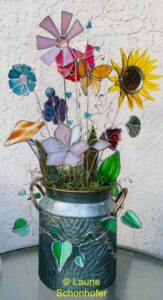
Steven Clarke sent pictures of this lovely transom window made from waste art glass:
And here are lots of fantastic ideas from members of the Stained Glass Hub (my private student community) who have kindly given permission for me to share their scrap glass creations:
Here is another idea from Aristide Hagiu
Fused Gems or Pearls From Scrap Glass
This is a lovely simple idea from Michel De Smedt. He collects the glass cullet in small plastic boxes. He then cuts it into small pieces which are then fused in the kiln at 815°C/1500 F for 5 to 10 minutes. After firing they become gorgeously gem or pearl-like.
Then they’re individually foiled, with solder in between them filling up the gaps.
Patina to blacken the solder.
TIP: If you don’t have a kiln you could pay a local studio or stained glass shop to fire them for you.
If you do have a kiln, make sure you either have kiln wash or ThinFire paper underneath the glass otherwise the pieces will stick to the shelf.
You can use any type of stained glass (not just fusible) but some may devitrify (an unsightly bloom on the surface). Just discard these and take note not to include that type of glass next time. Make sure none of the pieces are touching as they may not be the same COE and will crack as a result.
- The glass is cut and fired in the kiln to create these lovely rounded gems
2. The design phase is a wonderful combination of responding to the shapes in both the stained glass and the shapes of the gems.
The gems are NOT fused to the base glass – the middle photo above is for design purposes only, to assess the flow of the blue/green glass.
Michel’s completed works.
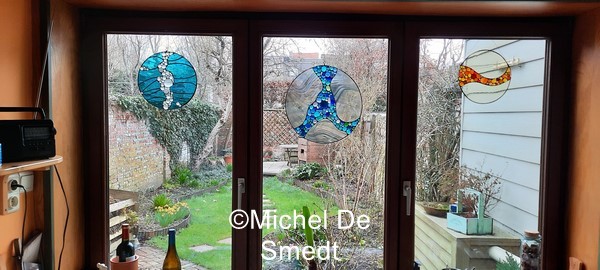
Michel says: “The challenge of using scrap glass well is being able to get the glass to work together to suit the scrap project. It’s very different from specifically choosing the glass. It’s a fun conundrum!”
I think you’ll agree that this is a fabulous way of using scrap glass and the conundrum has been solved beautifully 🙂
Question: As you know we always have pieces of scrap glass after completing a project (sometimes very small). Is there a rule of thumb for the size of scrap glass you would keep versus discarding?
Milly’s Answer:
I don’t go too tiny – 2″ square is as small as I’d go for special glass. 3″ square for more standard glass. Any smaller and overwhelm follows quickly!
If you’re a mosaicist, any size will find a home.
Here are some more decorative ideas for smaller bits of scrap glass and wire
If you need some additional inspiration to get you started, you could have a look at this Stained Glass Project book by Lynette Wrigley (affiliate)
If you have any ideas of your own, I’d love to hear about them below. Thanks in advance.
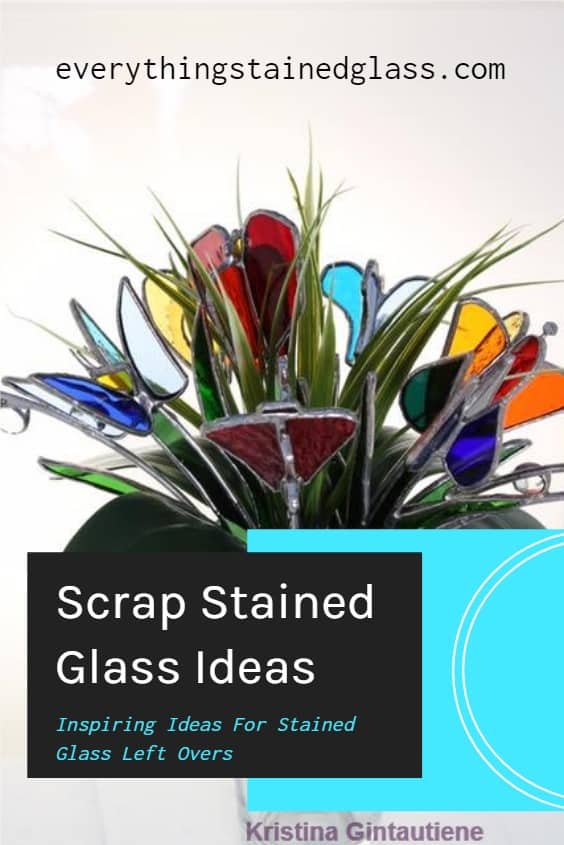

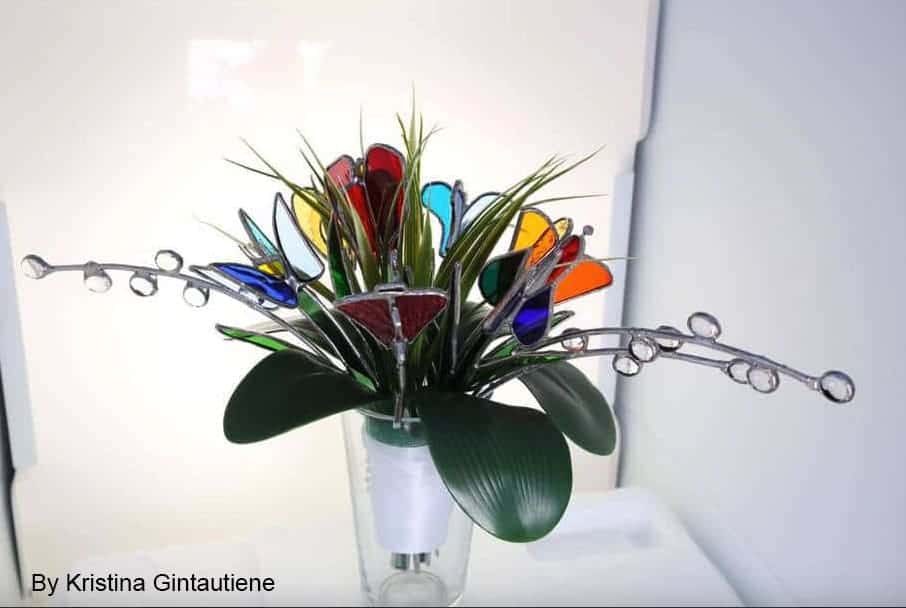
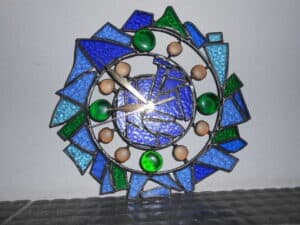
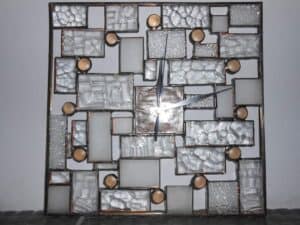

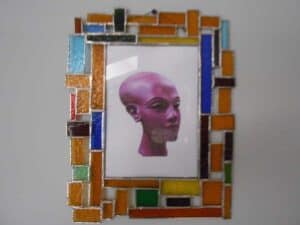
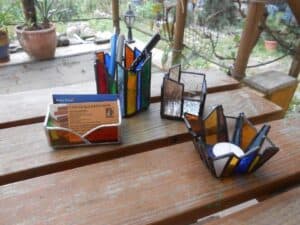
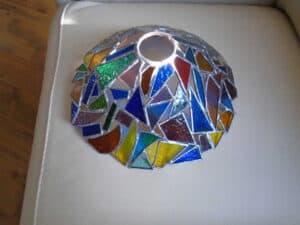
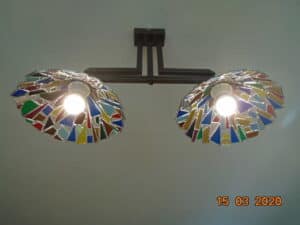
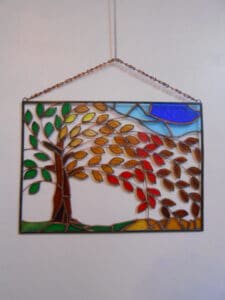
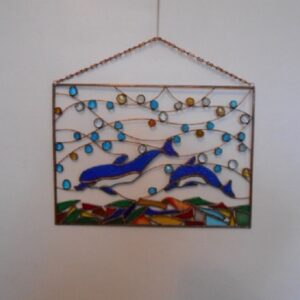
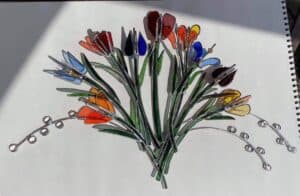
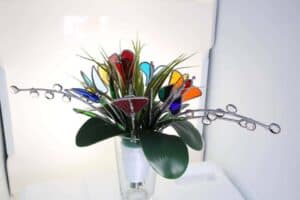
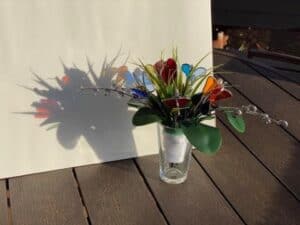

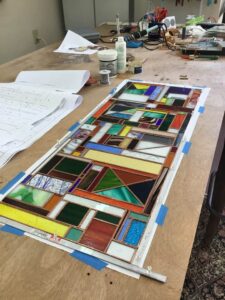
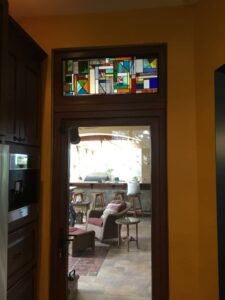
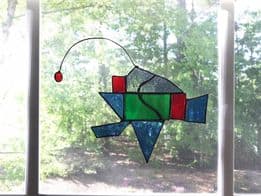
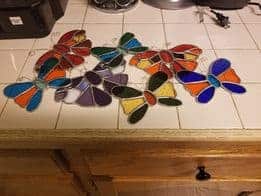
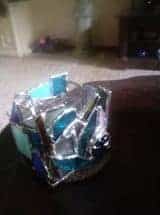
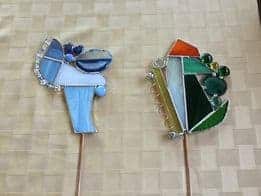
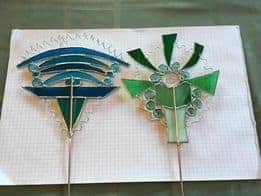
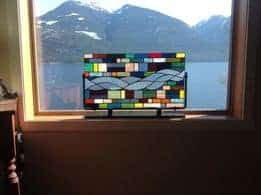
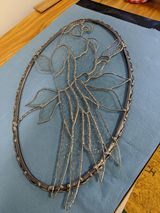
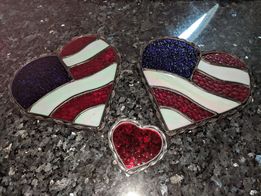

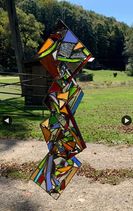

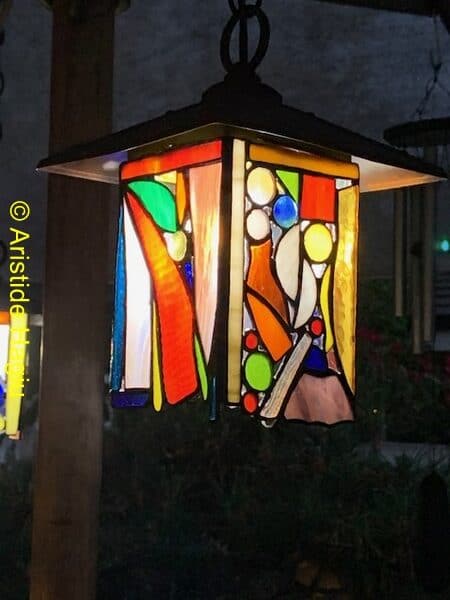
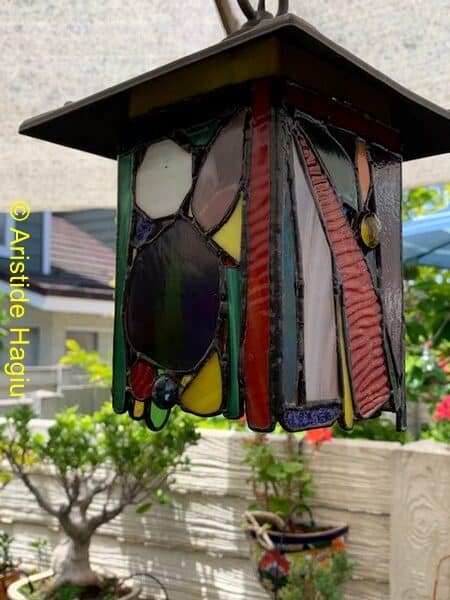

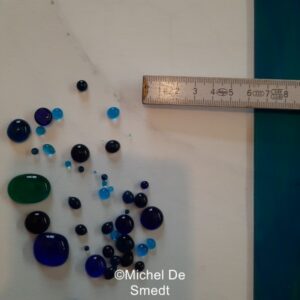
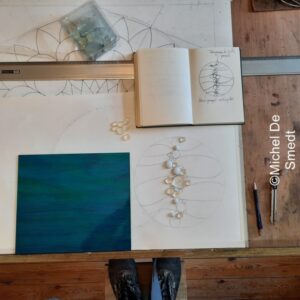
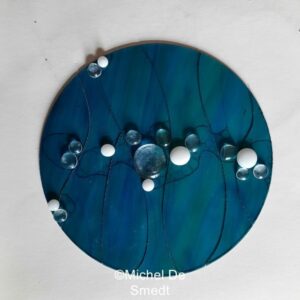
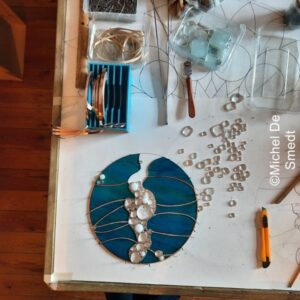
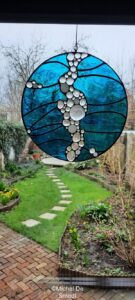
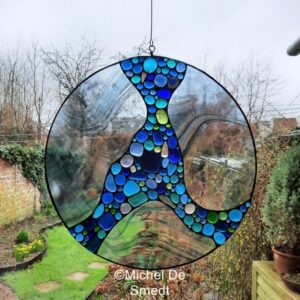
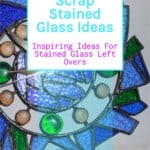
Hi Milly”
I am a stained glass aficionado and am learning glass fusing. I am wondering if Michel would be willing to share the programming steps he uses to produce the glass gems?
By that, I mean the ramp speed, hold time, soak time, etc.
Feel free to release my e-mail to Michel if you prefer they deal with me direct.
Thank You.
Paul Schmidt
The schedule is in the article Paul – with small pieces you don’t need to worry so much about the firing speed up and down. My suggestion would be to experiment with your own kiln and see… all kilns and different glasses behave differently. Good luck.
Hu, first ty for your tips, I share with friends who r newbies with stained glass. I’ve been kiln firing/fusing for a long time & along the way I’ve worked with upcycled 1800s stained glass, modern stained glass, window/float glass, 90 coe, and 104 coe & boro. I taught recycled glass mosaic, fusing, & lampworking classes for the Illinois Arts Council using donated window/float, safety glass, & stained glass. With antique stained glass, mine is 1894, some colors change into unpleasant browns blacks and may crumble. Vintage, antique Cathedral, opaque, & streaky glass usually don’t fire well (this includes 20th century to current glass). Each type of glass fires/fuses at different temps due to chemical composition.
A tip to remember is u can usually fuse glass pieces together that r from the same piece/cut, to keep the shine u can apply a very thin coat of Borax mixed with water to the top.
Most marbles are fun to fire, avoid contact in kiln.
There is a few excellent websites with free fusing info including directions for firing different glasses, schedules, etc. There’s a world of cool things u can do with a small microwave kiln & glass. For example http://Www.warmglass.com, http://www.warmglass.co.uk
This is great information, thanks so much for sharing that Barb. So helpful for people 🙂
I just tried to melt my scrap. I only work with stained glass type glass. None of my pieces changed. Is it the glass or the temperature. I fired at 815 for 10 min. Thanks
Different glasses have different melting points Sandi. And all kilns behave a little differently too. You’ll have to experiment with upping either the top temperature or the soak time. Let us know how you go to help others 🙂
Stained glass needs much higher temps to move/contract, usually 1500 degrees.
1500F = 815C so it’s the same temperature Sandi 🙂
Hi Milly,
I never throw out scraps that can be used.
I make plant and garden sticks with broken china and scraps.
Great use of scraps Harriet, thanks.
I have also used scrap’s of glass and included house number in the glass they have all gone down well with friends and family .
Great idea for the house numbers Pete, thanks.
Lovely ideas! But remind people, if fusing any scraps, that COE (Coefficient Of Expansion) must be known. Mixing glass of unknown or differing COE when fusing, will result in unpredictable and hazardous fracturing– and it can happen even years later. Don’t take the chance, especially if gifting or selling to others.
Thanks Lisa. These pieces are individually foiled, with solder in between them filling up the gaps so different COE is fine in this instance. But they have to avoid pieces touching, good reminder 🙂
Many times the small pieces can be fused together on the same shelf with larger projects to save energy and money. I find this particularly true when paying to have the fusing done at a local art glass studio.
Great money saving tip John, thanks so much.
Lovely idea! How are the little pieces attached? They don’t look foiled…
They’re individually foiled, with solder in between them filling up the gaps Maggie. Patina to make black.
Are the glass jewels foiled or glued onto clear glass?
They’re individually foiled, with solder in between them filling up the gaps Sharon. Patina to make black.
Great ideas. Thank you for your emails.
What type of transparent glue is used for mosaics or scrap glass project? Thanks
You can use E6000 Lita. Other people may have other ideas too. These aren’t stuck, they’re foiled and soldered.
This is a great article. I have three questions:
1) I enjoyed Michel de Smedt’s work. How are the gem pieces held together? I’m guessing each piece is foiled, and the spaces in between are filled with solder that is darkened by patina.
2) Do you have an affiliate link to the book Scrap Stained Glass Ideas by Kristina Gintautiene?
3) I have a Paragon kiln at home, but haven’t explored beyond firing painted glass for stained glass panels. Your including temperature and time is a helpful piece of information. I haven’t sorted my scrap glass into stained only vs stained-fusible. If I have regular old stained glass in a kiln tray at 815°C for 5 to 10 minutes, will I damage the kiln?
Thanks for your great postings,
Marty
1. Spot on with the construction, Martin. I should’ve added it to the article.
2. There isn’t a book, sadly – just this page of different ideas. But thanks for thinking of me for the affiliate, that’s kind.
3. No, you won’t damage the kiln Marty. Just make sure you either have kiln wash or ThinFire paper underneath the glass otherwise it’ll stick to the shelf.
4. Any stained glass will round off but some may devitrify (an unsightly bloom on the surface). You can just discard these and take note for next time. Make sure none of the pieces are touching as they may not be the same COE and will crack as a result.
I hope that helps.
That helps a lot – thanks, Milly.
Michel’s “River of Gems” rings are lovely! But, the gems don’t look like they are foiled. How are they held in place and how did he get the material that surrounds the gems to turn black?
Thanks, Milly!
They’re individually foiled, with solder in between them filling up the gaps Vicki. Patina to make black.
Nice one. And thank you for sharing.
Have a great 2024 everyone.
Odd shaped pieces of scrap glass can be “fire polished” in a kiln, drilled with a Dremel and then strung with glass beads to make beautiful outdoor hangars.
Oooh, sounds sparkling lovely Linda, thanks for the tip 🙂
I have a clay kiln. Can I use it to make these gems or fuse other glass? Is shelf paper a special kind for fusing/making gems or does kiln wash work?
Yes you can use a pottery kiln. You just have to be careful it’s 100% clean. Kiln wash will work or you can get ThinFire paper.
How are the globs (either fused ones or the ones you can buy) joined together? I can’t imagine that each piece was wrapped with copper tape and soldered? What is the method for joining lots of globs together.
They’re individually foiled, with solder in between them filling up the gaps. It doesn’t take that long, you can foil them roughly and shake them in a small tupperware container or similar.
You can also pre tin your globs, that usually makes it easier when you go to solder them together.
Yes, great addition to the page Connie, thanks for adding that 🙂
I make eyes for animals from scraps. I fuse them together in a microwave kiln.
Also I am mainly a metal artist but am learning stained and fused glass to accent metal arts. I’ve found that Rustoleum Triple Glaze spray makes glass much shinier than wax. It’s easy too. I use it on metal often.
Great ideas here Bonny, thanks. I love metal and glass and am jealous of your metalwork skills.
I don’t use wax for the glass, I use it to protect the solder seams.
I get Dollar store solar garden stakes and fill them with smashed scrap glass.
That sounds interesting Pamela, I bet they look lovely. Thanks for the idea.
Love the scrappy lanterns. Where can you purchase the metal roofs?
Hi Milly,
Thank you for sharing your beautiful work. My question is … do you have any suggestions on how to clean scrap glass? I have tons from a local sg artist but it is dusty and filthy.
Thank you,
Hope
Yes, go to this page and scroll down to find the section on cleaning dirty glass: https://everythingstainedglass.com/stained-glass-sheets
I get a bin of warm water and with little Dawn dish soap. Carefully scrub if needed, rinse, then lay on towel and wipe dry. I love scraps.
I was given a lot of leftover glass and made stepping stones, well not for stepping, but for beauty, large flowers, used Gorilla clue to attach glass, beautiful in the sun!
Thank you for this Denyse, I can see them in my mind’s eye right now 🙂
Love the idea What do you use for the stems of the flowers
I’m not sure which exactly you’re referring to Linda, but stems are usually made from tinned copper wire.
I hope that helps.
Hi Milly
I have used a considerable amount of my leftover glass to make mosaic type small tables …..about to make a sixth. Some abstract and some with patterns of birds, flowers etc.
Lots of fun.
Your mosaics sound lovely Marie; a nice idea for using up those scraps of glass. Thanks.
Another great idea to use up scraps are the scrappy birds I have seen on Pinterest
Thanks for the reminder Lilo.
Love the scrappy pieces. In the first photo (blue clock piece), what is used for the wire structure? Is that tinned heavy gauge copper or something else? Thanks.
It looks like foil and solder to me Kimme. Or am I misunderstanding what you mean?
Yes Looks to me like they used a thick piece of tinned copper wire to make the spiral, then added all the pieces onto it the usual way with foil and solder.
Milly,
Wonderful ideas for using all those pieces of glass that are too beautiful to throw away. Loved the abstract by Stephanie Klenka Mitchell and others.
I look forward to your email each week, they get more helpful every time. Great subject matter!
Thank you,
Bob in Nebraska USA
Oh that’s a nice comment Bob, thank you 🙂 I’ll let the gang know that they’re all appreciated.
Lots of mosaic artists like me would be happy to purchase boxes of scraps as well! Keeps the glass going and out of landfills!
Yay to that! I’m sure you’d be inundated with scraps if you asked sg artists nicely 🙂
Everyone has scrap glass. Sending some from Baltimore to New Mexico for just cost of shipping.
Hi Tracy.
I have tons of scrap glass if you are interested.
Thank you Milly ,
I love using my left over pieces . They are great for Christmas ornaments and small items can be added to gift tags , to make them a bit special .
Umm ! Better get cracking !
Have a good day,
Barbara M.
Yes, quick! You have a couple of months so you should be okay 🙂